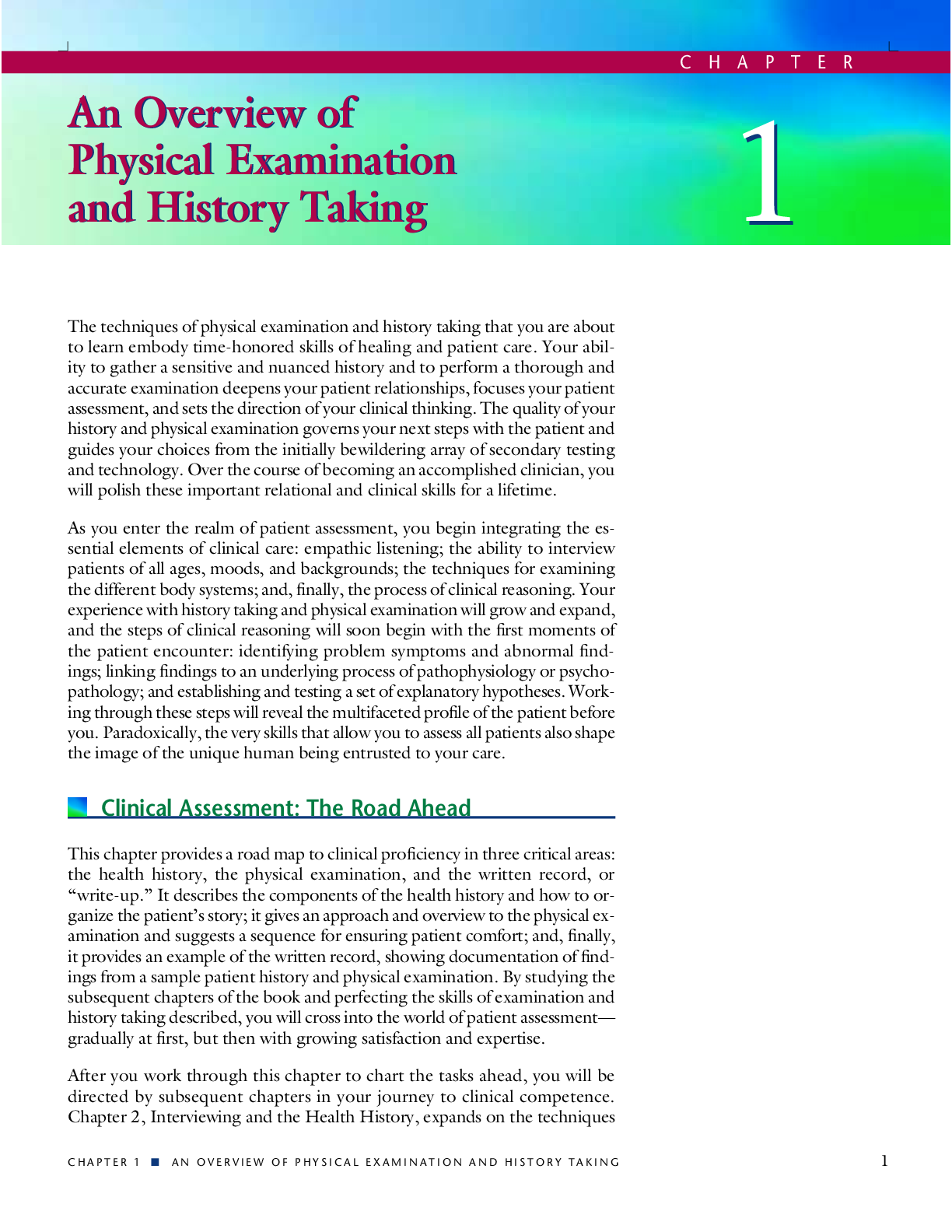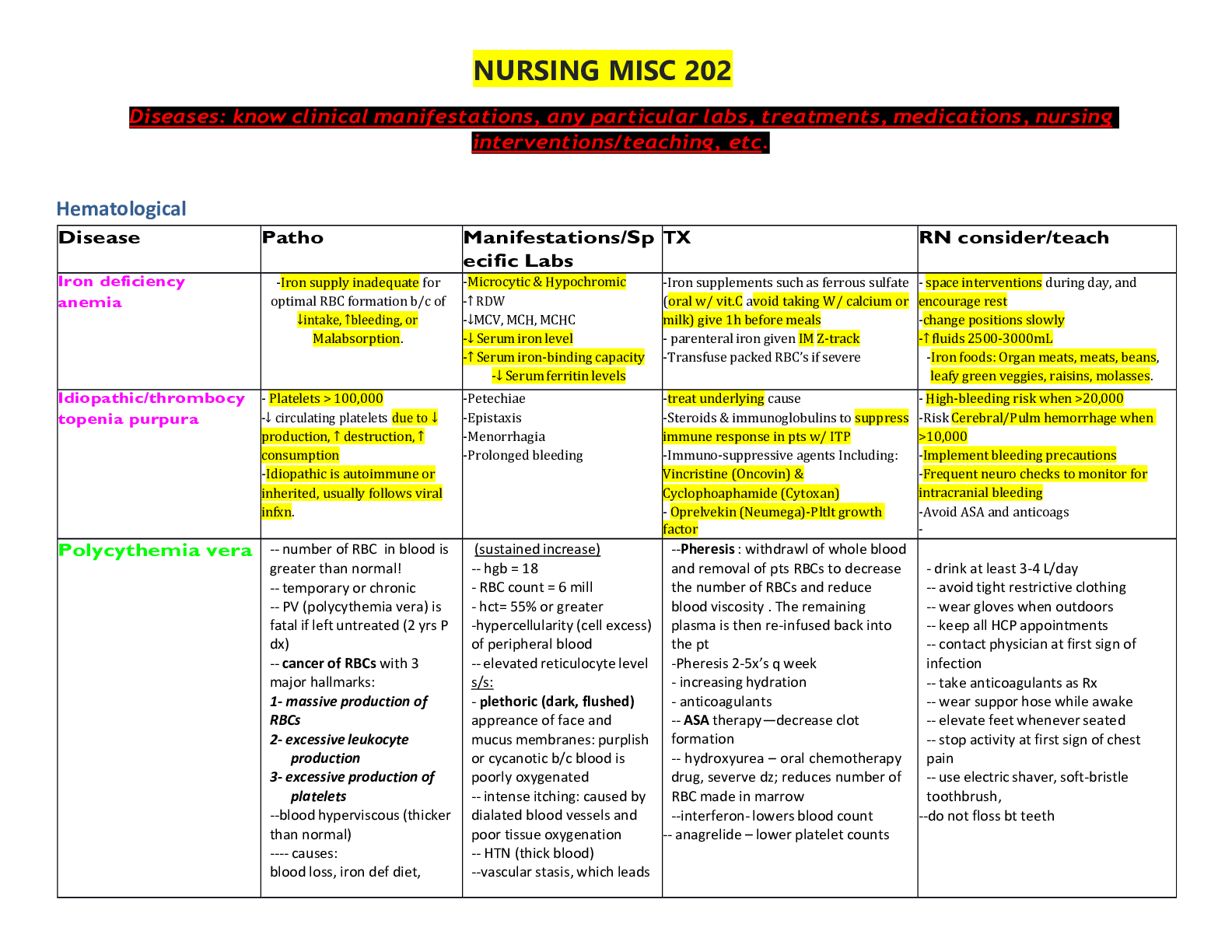Psychology > STUDY GUIDE > IB PSYCHOLOGY HL FULL PAPER 1 NOTES 2021 YOUR GUIDE TO A7 > (ALL YOU NEED TO KNOW FOR IB PSYCHOLOGY (All)
IB PSYCHOLOGY HL FULL PAPER 1 NOTES 2021 YOUR GUIDE TO A7 > (ALL YOU NEED TO KNOW FOR IB PSYCHOLOGY PAPER 1, FROM AN IB PSYCHOLOGY HL '7' GRADUATE)
Document Content and Description Below
The Sociocultural level of analysis (SCLOA) is the scientific study of how people's thoughts, feelings and thus behaviours are influenced by actual, implied or imagined presence of others. There are... multiple principles to the SCLOA. Three that we will be focusing on are: Social and cultural factors influence individual behaviour. S1 We want connectedness with a sense of belonging. S2 We construct our conceptions of the individual and social self S3 It is recommended that you remember these principles word-for-word. The attribution theory is based on the assumption that people tend to look for causes and reasons for others’ behaviour because they expect that there are motives behind most of their own behaviour. People seem to have a pervasive need for causal explanations because this makes the world more predictable. Attribution theory is based on the assumption that people: are “intuitive psychologists” who construct their own causal theories of human behaviour construct causal theories because they want to be able to understand, predict, and control the environment around them. A dispositional attribution is when an internal factor within the person (e.g. personality, values) is attributed to their behaviour. A situational attribution is when an external factor outside the person (e.g. environment, social group) is attributed to their behaviour. Example: If a person arrives late to school, we can assume that they are a lazy person (dispositional factor) or the bus was late (situational factor). STUDY: Zimbardo (1971) AIM: The aim of Zimbardo (1971) was to examine the effects of being assigned the role of a prisoner or a prison guard on one's behaviour. METHOD: Participants answered a local newspaper ad calling for volunteers in a study of the psychological effects of prison life. To make sure everyone was "healthy, intelligent, middle class males" participants went through a series of psychological tests. The 24 participants were randomly allocated to the position of guards or prisoners. The prisoners were blindfolded and then taken to prison. The prisoners were humiliated. This consisted of shaving the prisoner's head, they were given a uniform and they were only referred to as numbers. The guards were given no specific training and were free to do whatever they want in the prison. The guards punished the prisoners by demanding push-ups from them. Some prisoners who were particularly rebellious were put into solitary confinement. RESULTS: The results showed that the prison simulation had become real. The prisoners appeared to have lost their sense of identity. The guards had become violent, while the prisoners showed signs of depression and helplessness. Prisoner #8612 suffered mental breakdowns less than 36 hours into the experiment and was kept from leaving. CONCLUSION: Therefore, it was concluded that situational attributes significantly impact behaviour. The fundamental attribution error (FAE) occurs when people overestimate personality traits (dispositional factors) and underestimate environmental factors when they explain other people’s behaviour. People rely too much on personality in explaining behaviour and they underestimate – or never consider – the power of situations. 4 In Western societies it could be because of the ideology that people get what they deserve. It makes life more predictable if people’s behaviour is mainly caused by their personality. This gives the impression that people are understandable and easy to deal with. Explanations based solely on personality are incomplete. It would be wrong not to consider the power of situation. Self-serving bias is when internal, dispositional factors are attributed to one's success while one's failure is blamed on their external, situational factors. People tend to make attributions in line with "bad things happen to bad people" and "good things happen to good people" in order to protect their self-esteem and prevent feeling vulnerable. We tend to take credit for our successes, identify an internal cause, and dissociate from our failures, blaming external factors. Defensive attributions are one type of self-serving bias; they involve explanations for actions or outcomes that are made to avoid feelings of vulnerability and mortality. Unrealistic optimism is a form of defensive attribution in which people think that positive events are more likely to happen to them than to their peers, and that negative events are less likely to happen to them than to their peers. The greater the consequence of an action, the more that attribution will be dispositional rather than situational. STUDY: Ross et al. (1977) AIM: The aim of the Ross et al. (1977) experiment was to test whether knowledge of allocated social roles in a quiz show would affect participants’ judgments of expertise. METHOD: The researchers recruited participants from an introductory class at Stanford University. The researchers simulated a game show and participants were randomly assigned to the roles of either questioner or contestant. The questioners were asked to compose ten general knowledge questions that were challenging but not impossible. Six pairs of each sex were assigned to the control condition. In this condition, the questioners and contestants were told that the questions were made up by another person. The independent variable was whether the questions were prepared by the questioner (experimental condition) or by someone else (control condition). The dependent variable was the knowledge ratings of the contestant and the questioner. The questioner was instructed to ask each question and then wait around 30 seconds for a response. This was done without any other communication between the questioner and the contestants to avoid confounding variables. RESULTS: The results showed that on average, contestants got only 4 out of 10 questions right in the experimental condition. The contestants consistently rated the general knowledge of the questioners in the experimental condition as superior to that of the contestants. The observers did the same. In the control condition, there was no difference in general knowledge ratings. CONCLUSION: The results demonstrate that the fact that the questioners could make their own questions led to higher general knowledge ratings from both contestants and observers. The dispositional factors affected the contestants' perception of the questioners. The fundamental attribution error was shown when the contestants and observers failed to take into consideration any of the situational factors. In the Social Identity Theory (SIT), a person has not just one “personal self”, but rather several social selves that correspond to widening circles of group membership. Social identity can be defined as the part of one’s self-concept based on the knowledge of membership in social group(s) in combination with the value and emotional significance attached to that membership. Individuals strive to maintain a positive self-concept as well as a positive social identity. People make comparisons between in-group and out-group on valued dimensions to establish, maintain, and defend positive in-group distinctiveness (social comparison). The SIT is principle S3 of the SCLOA. Social categorization is the process by which we identity which groups we belong to and which groups we do not. 5 The groups we belong to and identify with are referred to as our "in-groups". When referring to our ingroup, we often use the words "we" and "us". The groups that we do not belong to, are referred to as "out-groups". When referring to our out-groups, we often use the words "they" and "them”. After identifying one's in-group, individuals then engage in social comparison which is a means of justifying their group membership. We seek to achieve positive self-esteem by positively comparing our in-group to an out-group on some valued dimension. We favour the traits of our in-group, even if we did not necessarily choose to be a part of the group ourselves. The three stages of SIT can be simply remembered as: 1. Social categorization 2. Social comparison 3. The tendency for people to use group membership as a source of self-esteem STUDY: Tajfel (1970) AIM: The aim of the Tajfel (1970) study was to demonstrate the minimal group paradigm in creating in-group bias. METHOD: 64 schoolboys (aged 14-15) from Bristol, UK, were randomly allocated into groups based upon minimal characteristics. In the first study, the boys were placed into groups based upon their estimates of the number of dots on a screen in a visual judgement task. These groups were labelled as ‘overestimator’ or ‘underestimator’. However, this was not true and was purely done to categorize the boys. The boys were then involved in a task where they had to give rewards and penalties via money (a small value of 50p) to others. The boys would not know the identity of who they were allocating money to and were told that none of their decisions would benefit or punish them. The boys were placed in cubicles and given a booklet with a matrix. These matrices enables in-group choice, out-group choice and intergroup choice. RESULTS: The results found that when the boys were required to make an intergroup choice (allocate rewards or penalties to one of their own group or a member of the out-group) they displayed more in-group favouritism and allocated more rewards to their own group. When allocating rewards or penalties to two members of the same group, ingroup or out-group, the boys opted for a decision that would give maximum fairness (when we are aware of an out-group we will discriminate in favour of an in-group). The participants maximised differences between the groups. CONCLUSION: It can be concluded that the idea of being in a group is enough to induce own group bias (minimal group paradigm). A stereotype is a cognitive representation of a social group that helps simplify the social world and allow assumptions to be made about a person based on limited information. It is a generalisation that is made about a group, which is then attributed to members of that group, helping us to predict the behaviour of others (e.g. it is a stereotype that Asians are smart). Stereotypes are often acquired indirectly from other people and social norms and not from personal experience. Stereotyping affects behaviour of people who hold the stereotype, and people who are labelled by a stereotype. One effect of stereotypes on behaviour is the stereotype threat. The stereotype threat is when an individual is in a situation where there is a threat of being judged or treated stereotypically, or a fear of doing something that would inadvertently confirm that stereotype. The stereotype threat can influence one's performance and lead to spotlight anxiety, which causes emotional distress and pressure that may undermine the behaviour of intellectual performance. The origin of stereotypes can be explained by the social identity theory. The SIT can be linked to stereotypes because people often have preconceived ideas about an out-group. STUDY: Steele & Aronson (1995) 6 AIM: The aim of Steele & Aronson (1995) was to determine if stereotype threats would negatively affect the intellectual performance of African Americans. METHOD: The experiment was composed of four studies with males and females. The black and white participants were divided into random groups and were given a test to complete. Their performance was marked. The studies mainly comprised of a diagnostic group (a group told that the test would reflect their reading and verbal abilities) and a nondiagnostic group (a group told that they will be used for studying problem-solving). RESULTS: The results found that the African American participants of the diagnostic group (stereotype threat condition) performed worse than White participants. The African Americans in the diagnostic group performed worse than those in the non-diagnostic group. In non-diagnostic groups, African Americans and Whites performed roughly equal, with no significant difference. The African American participants showed more lack of confidence than the Whites when faced with the stereotype threat. CONCLUSION: It can be concluded that the stereotype threat occurs when one is in a situation where there is a threat of being judged or there is a fear of doing something that would inadvertently confirm the stereotype. The blacks were threatened with the stereotype that black people have low intelligence, which caused them to be fearful of their results and judgement. This activated their self-doubts of confirming the stereotype and weakened their academic performance and motivation. The social learning theory (SLT) suggests that behaviour is learned from the environment through the processes of modelling, reinforcement, and the stages of observational learning. Modelling involves learning through the observation of other people, which may lead to imitation if the behaviour is to be imitated leads to desirable consequences. Vicarious reinforcement is the inclination to imitate or copy others' behaviour because they are being rewarded. Observational learning is a four step process. The four steps are: attention, retention, production processes and motivation. 1. Attention is focusing on the modelled behaviour. 2. Retention is recalling the modelled behaviour. 3. Production processes is evaluating the skills needed to reproduce the modelled behaviour. 4. Motivation is considering if the modelled behaviour is needed and if vicarious reinforcement occurred. The SLT is principle S1 of the SCLOA. STUDY: Bandura (1961) AIM: The aim of Bandura (1961) was to investigate the extent to which children would imitate aggressive behaviour if they were to observe an aggressive display by an adult. METHOD: The method was a laboratory experiment. The design of the experiment has three major conditions; the control group, the group exposed to the aggressive model, and the group exposed to the passive model. In stage one of the experiment, children were brought to the experimental room by the experimenter, and the model, who was in the hallway outside the room, was invited to come in. After settling the child in the play corner the adult model was escorted to the opposite corner of the room where there was a small table, chair, tinker-toy set, a mallet and a five foot inflatable Bobo doll. In stage two the child was subjected to 'mild aggression arousal'. The child was taken to a room with relatively attractive toys. As soon as the child started to play with the toys the experimenter told the child that they could not play with the toys. For stage three of the study, the child was told it could play with any of the toys in there. In this stage there were a variety of both non-aggressive and aggressive toys. The aggressive toys included a mallet and peg board, dart guns, and a 3 foot Bobo doll. RESULTS: The results found that the children in the aggressive model condition made more aggressive responses than the children in the non-aggressive model condition. CONCLUSION: It can be concluded that the findings support the Social Learning Theory. [Show More]
Last updated: 1 year ago
Preview 1 out of 42 pages

Reviews( 0 )
Document information
Connected school, study & course
About the document
Uploaded On
Jul 05, 2021
Number of pages
42
Written in
Additional information
This document has been written for:
Uploaded
Jul 05, 2021
Downloads
0
Views
40




.png)
.png)




.png)
.png)







 (1).png)











.png)



